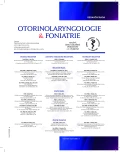Development of Children´s Maxillary and Ethmoid Sinuses According to the Computed Tomography – Volumetric Study
Authors:
P. Koblížková 1,2; Pavel Komínek 1,2; M. Plášek 1,2; L. Čábalová 2; J. Mičaník 3; Petr Matoušek 1,2
Authors‘ workplace:
Klinika otorinolaryngologie a chirurgie hlavy a krku, Fakultní nemocnice Ostrava
1; Katedra kraniofaciálních oborů, Lékařská fakulta, Ostravská univerzita
2; Ústav radiodiagnostický, Fakultní nemocnice Ostrava
3
Published in:
Otorinolaryngol Foniatr, 68, 2019, No. 3, pp. 131-134.
Category:
Original Article
Overview
Objective: The objective of this study is the analysis of the development of ethmoid air cells and maxillary sinus by measuring their volume by the high resolution computed tomography. The measurements were done on children from the age of 0 to 18. The knowledge of the development of paranasal sinuses has a clinical importance especially for the diagnosis and medical treatment of children´s rhinosinusitis and its complications.
Methodology: The children, who were included in this retrospective study, underwent the high resolution computed tomography of the head from different purposes than the patological diagnosis of paranasal sinuses. The patients were distributed into groups according to their age (0-1, 1-2, 17-18). The three-dimensional reconstruction and the capacity assessment were performed by means of the software OsiriX v. 5.8.1. The maxillary sinus and ethmoid air cells were measured. The results were statistically processed.
Results: There were 180 patients included in this study (10 patients in each category 0-18). The paranasal sinuses were measured on both sides in all categories, i.e. there were 360 measurements in total. The maxillary sinus was present in the age group of 0 to 1 in 100% of all cases (volume 0,8 ml). At the age of 5 years, maxillary sinus volume was 3.8 ml, at the age of 10 years - 6.8 ml and at the age of 18 years the average volume of maxillary sinus was 20.7 ml. The ethmoid air cells were present in the age group of 0 to 1 in 100% of all cases (volume 0,4). At the age of 5 years, ethmoid air cells volume was 1.4 ml, at the age of 10 years - 3.4 ml and at the age of 18 years, the average volume of ethmoid air cells was 4.8 ml.
Conclusion: The results of this study show that ethmoid air cells and maxillary sinus are develop at the age of 1year in 100% of all cases. The results of this study do not allow us to draw a conclusion on the end of the development of the maxillary sinus and ethmoid air cells. Considering the shape of the developmental curves, it is possible to presume that their development is finished later than 18.
Keywords:
paranasal sinuses – development – rhinosinusitis – volumometry
Sources
1. Apuhan, T., Yildirim, Y. S., Ozaslan, H.: The developmental relation between adenoid tissue and paranasal sinus volumes in 3-dimensional computed tomography assessment. Otolaryngol Head Neck Surg, 144, 2011, 6, s. 964-971.
2. Fernandez Sanchez, J. M., Anta Escuredo, J. A., Sanchez Del Rey, A. et al.: Morphometric study of the paranasal sinuses in normal and pathological conditions. Acta Otolaryngol, 120, 2000, 2, s. 273-278.
3. Hybášek, I.: Klinická anatomie, fyziologie a patologie ucha, nosu a krku. V: Hybášek, I.: Otorinolaryngologická propedeutika. Ušní, nosní a krční lékařství. 1. vydání. Praha, Galén, 1999, s. 17-18.
4. Ikeda, A., Ikeda, M., Komatsuzaki, A.: A CT study of the course of growth of the maxillary sinus: normal subjects and subjects with chronic sinusitis. ORL J Otorhinolaryngol Relat Spec, 60, 1998, 3, s. 147-152.
5. Jun, B. C., Song, S. W., Park, C. S. et al.: The analysis of maxillary sinus aeration according to aging process; volume assessment by 3-dimensional reconstruction by high-resolutional CT scanning. Otolaryngol Head Neck Surg, 132, 2005, 3, s. 429-434.
6. Kim, H. J., Park, E. D., Choi, P. Y. et al.: Normal development of paranasal sinuses in children: A CT study. J Korean Radiol Soc, 29, 1993, 6, s. 1313-1319.
7. Lorkiewicz-Muszynska, D., Kociemba, W., Rewekant, A. et al.: Development of the maxillary sinus from birth to age 18. Postnatal growth pattern. Int J Pediatr Otorhinolaryngol, 79, 2015, 9, s. 1393-1400.
8. Marseglia, G. L., Castellazzi, A. M., Licari, A. et al.: Inflammation of paranasal sinuses: the clinical pattern is age-dependent. Pediatr Allergy Immunol, 18, 2007, Suppl 18, s. 10-12.
9. Marseglia, G. L., Pagella, F., Caimmi, D. et al.: Clinical presentation of acute rhinosinusitis in children reflects paranasal sinus development. Rhinology, 45, 2007, 3, s. 202-204.
10. Masri, A. A., Yusof, A., Hassan, R.: A three dimensional computed tomography (3D-CT): a study of maxillary sinus in malays. CJBAS. September, 1, 2013, 2, s. 125-134.
11. McDermott, A. L.: Pediatric ear, nose and throat emergencies. In: Clarke, R. W. Pediatric Otolaryngology: Practical clinical management. New York, Thieme, 2017, s. 33-45.
12. Park, I. H., Song, J. S., Choi, H. et al.: Volumetric study in the development of paranasal sinuses by CT imaging in Asian: a pilot study. Int J Pediatr Otorhinolaryngol, 74, 2010, 12, s. 1347-1350.
13. Schalek, P.: Nos a vedlejší dutiny nosní. V: Hahn, A. et al. Otorinolaryngologie a foniatrie v současné praxi. 1. vydání. Praha, Grada, 2007, s. 127-130.
14. Smith, S. L., Buschang, P. H., Dechow, P.C.: Growth of the maxillary sinus in children and adolescents: A longitudinal study. Homo, 68, 2017, 1, s. 51-62.
15. Weiglein, A., Anderhuber, W., Wolf, G.: Radiologic anatomy of the paranasal sinuses in the child. Surg Radiol Anat, 14, 1992, 4, s. 335-339.
16. Wolf, G., Anderhuber, W., Kuhn, F.: Development of the paranasal sinuses in children: implications for paranasal sinus surgery. Ann Otol Rhinol Laryngol, 102, 1993, 9, s. 705-711.
Labels
Audiology Paediatric ENT ENT (Otorhinolaryngology)Article was published in
Otorhinolaryngology and Phoniatrics

2019 Issue 3
Most read in this issue
- Rhino-orbital Mucormycosis
- Development of Children´s Maxillary and Ethmoid Sinuses According to the Computed Tomography – Volumetric Study
- The Specific Language Impairment in Bilingual Children
- Tracheal Stenosis Caused by Nodular Goiter in a Patient after Previous Tracheostomy
